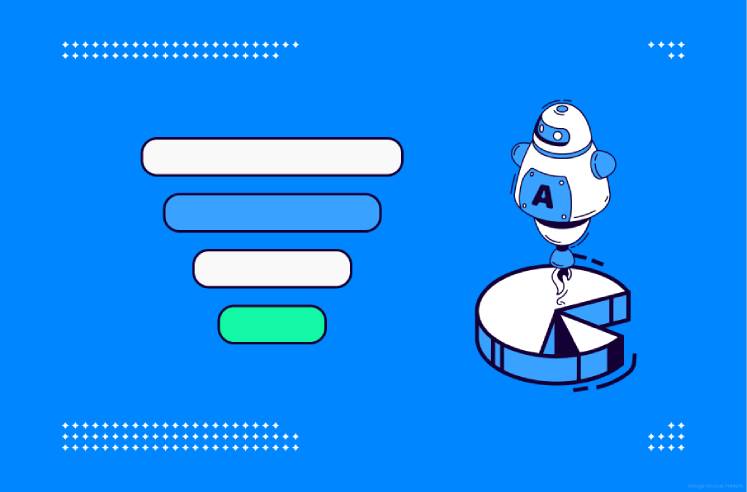
Last year, the former president of Google China, Kai-Fu Lee, dropped a bombshell by predicting that white collar roles would be the first to be automated, putting marketers, sales teams and content creators in the direct firing line. But before sales representatives start shaking in their headsets in fear of losing their jobs, it is important to note that the common consensus amongst sales industry experts is that AI is still nowhere near matching humans in capabilities of building relationships, developing trust and ultimately selling products.
The first wave of basic AI applications have been in use in the field of sales for a number of years, which instead of replacing humans entirely, have taken over menial roles at the top of the sales funnel. In turn, this has freed up more time for sales reps to follow leads, and secure potential clients.
However, we are now on the cusp of the second wave of AI in sales. We will see AI applications emerge that can really drive sales tactics, and augment tactical decisions at the bottom end of the sales funnel for Sales VPs and operations managers.
So let’s take a look at the advancement of AI in sales to date, and make some predictions about how this technology will make real changes to the industry in the not so distant future:
The First Wave – Automating Menial Tasks
Across a range of industries — from marketing to sales to accounting — we have begun to see ‘soft’ AI applications reducing the strain on human teams for fairly basic, yet time-consuming tasks.
To date, most of the applications of AI in sales software has been limited to sales enablement, freeing up more time for sales teams by automatically replying to emails or chat requests, identifying buyer intent, or engaging customers to assess their potential value via chatbots or emails.
The day to day tasks of BDRs (Business Development Reps) and SDRs (Sales Development Reps) who find and qualify potential leads, are already being made much easier by AI solutions which can comb through hundreds of millions of interactions on the internet to identify prospects who are showing intent to buy .
For LRRs (Lead Response Reps) who are responsible for responding to inbound inquiries, there are tools which offer AI-powered chatbots, which can begin engaging inbound leads, and gathering information which can be used to qualify them.
While these applications are undoubtedly important, as they save time for those at the top of the sales funnel, they are merely an essential cog in sales machine. They help with low value tasks which can be done by comparatively low skilled workers. At the end of the day these AI applications offer relatively limited value to tactical decision makers responsible for driving deals through the funnel.
The Second Wave – Augmenting Human Roles
As mentioned earlier, to date, AI applications have largely been used by sales leaders as a means of saving money by cutting human roles in sales/customer service and freeing up time in other areas. However it should be noted that, the quintessential role of the sales organization is to MAKE money, not to save cost. While decreasing the cost of sales is an important metric, B2B sales organizations are primarily tasked with increasing the number of successful sales transactions and maximizing revenue generation
As AI technology has advanced, and algorithms have gotten smarter, the second wave of AI in sales has started to see AI being harnessed to augment processes further down the sales funnel. This has begun to help sales organizations make better data-driven decisions, and boost overall sales as a result.
We have already seen a number of AI applications for sales coaching. Companies have created tools which record and store information from hundreds or thousands of sales calls daily, and then offer tips to sales teams about the tactics that are boosting sales the most.
However, for the second wave of AI in sales to really take hold, companies need to be able to take advantage of the huge amount of customer interaction data they are sitting on. Considering that nearly 90 percent of businesses now use cloud based CRM tools, companies now have access to huge sets of raw data, filled with hidden insights to use to their advantage.
Recording such data efficiently, however, presents another problem which AI has started to help with as well. Despite the fact that sales reps spend as much of 30 percent of their time on data entry, as much as 60 percent of their activities still go unlogged in CRM systems, leaving gaps in data, and adding compliance strains on sales managers.
There are available tools which take away this strain by automatically logging all of the data, and offering a more complete picture of sales activity. This enables managers to focus on more tactical work, rather than just cracking the whip.
Other AI applications also allow human teams to store and manage the huge flow of interaction data across channels, compare this data to existing and previous campaigns, and inform sales teams and decision makers to a point where they can separate the signal from the noise. As a result, they are able to make decisions based on hard data, rather than often misguided human intuition.
The ability to break down huge sets of data with AI applications allows teams to better:
- Minimize churn by analyzing large data sets based on interactions between customer success and support teams to improve overall customer satisfaction.
- Uncover potential upsell and cross-sell opportunities in real time by matching customer profile data with data from previous sales engagements.
- Improve customer lifetime value by targeting the particular customer segments that maximize customer lifetime value, and reducing the cost of customer acquisition.
The Third Wave – Driving Strategies at the Bottom of the Funnel
As AI technology matures, we are likely to see smart tools being increasingly used to drive sales strategies by managers at the bottom of the sales funnel too.
By correctly storing, cleaning up and analyzing their data, VPs of sales and sales managers will be able to roll out more agile sales processes, which are designed to create repeatable successes based on rapid experimentation with new sales tactics. Through this type of experimentation, AI would help sales managers find the holy grail of repeatable tactics/interactions with consumers, which will in turn boost top line in the long run.
These insights will allow sales teams to:
1) Target the right segments with the right products on the right channels at the right time.
2) Train new sales talent much quicker, based on techniques that are proven to be successful.
3) Gain insights from the tactics employed by their most successful reps, rather than lose customers every time a sales whiz moves on to another job.
4) Take a birds eye view of processes to maximize results — particularly for managers and VPs.
As more and more sales companies adopt AI applications at various stages of the sales funnel, the companies with largest data sets will end up having the biggest advantage. Traditionally, one of the biggest roadblocks to adopting, and training AI machine learning applications has been having access to enough proprietary data. This has left smaller companies, with less clean data, with no other choice but to harness “AI as a service” (AI-AAS) offerings from industry giants like Salesforce, Microsoft Azure and Amazon Web Services.
While these cloud services democratize access to AI, they also strengthen the powerhold of tech giants with every new startup that uploads their data to cloud platforms. With every small sales team feeding their data into Salesforce Einstein, for example, these startups / small sales teams will definitely to gain very useful insights, but they also become dependant upon “AI-AAS” platforms. If they later decide to build their algorithms they will effectively end up back to square one.
So to stay relevant, without becoming reliant on tech giants to make sense of their data, it is up to smart sales managers to start rolling out AI applications and training algorithms as soon as possible. Those who manage to successfully surf the waves of AI innovation will find themselves miles ahead of those competitors, who waited too long and let disruption come crashing down on top of them.
For more information about MoData offerings click here




